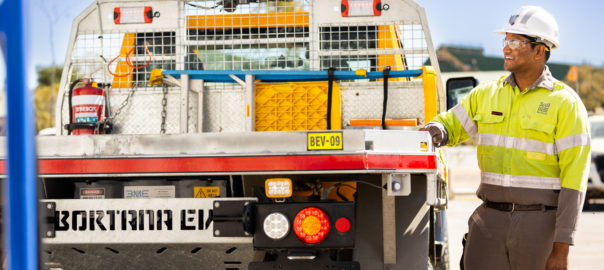South32’s greenhouse gas emission (GHG) reduction plans were established early on in the company’s life, with a long-term goal of achieving net zero operational GHG emissions by 2050 set in motion within a year of it coming into being.
It has since established a medium-term target to halve its operational GHG emissions by 2035, from its 2021 financial year baseline, with several initiatives already in play to achieve this aim.
The company’s approach to climate change is focused on:
- Reshaping its portfolio to the base metals deemed critical in the transition to a low-carbon world;
- Decarbonising its operations, with a focus on the four operations within its portfolio which account for the majority (93%) of its emissions profile (Hillside Aluminium, Mozal Aluminium, Worsley Alumina and Illawarra Metallurgical Coal (IMC));
- Understanding and responding to the potential physical impacts of climate change on its business to build operational resilience; and
- Working with others to innovate and address shared challenges across industry, and to decarbonise the value chain.
The company has made headway on all four of these objectives since settling on this focus.
The portfolio reshaping is coming good with advancements in base metal projects and an acquisition of a significant stake in the Sierra Gorda operating mine in Chile.
In its 2023 financial year, the company commenced conversion of its first coal-fired boiler to natural gas as a transitional step at Worsley Alumina, with an estimated abatement of up to 205,000 t/y of CO2-e; converted 18% of pots at Hillside Aluminium to AP3XLE energy efficient technology and completed four of five EnPot trials; and commenced detailed design and execution planning for a commercial scale trial of CSIRO ventilation air methane mitigator technology at IMC.
And, when it comes to working with others to innovate and address shared challenges across industry, South32 can point to work it is carrying out under the auspices of the Electric Mine Consortium (EMC) – a group of companies aiming to accelerate progress towards a fully electrified, zero carbon, zero particulates mine.
As the lead in both the electrical infrastructure workstream, and energy supply and storage workstream within the consortium, South32 has agreed to take significant steps on behalf of the industry.
On the latter workstream, it recently scanned the market for long duration energy storage through an expression of interest, which received submissions from over 20 vendors, targeting seven members’ use cases.
“The knowledge gained informed a pre-concept study of thermal energy storage at Worsley Alumina and a related steam electrification study,” South32 said in its most recent Sustainable Development Report.
And, when it comes to the former, the company intends to build on its experience trialling the Cat R2900 XE diesel-electric loader at the Cannington operation in Queensland, with plans to trial three battery-electric light utility vehicles and a battery-electric integrated tool carrier, also at Cannington.
These trials, expected to run for at least 12 months and to prove the use case of electric vehicles for underground mining – including safety, reliability, range and capability requirements – will see three Bortana light utility vehicles deployed, two of which have been configured for heavy duties and one configured as a supervisory vehicle; with a Batt Mobile Equipment (BME) BIT120 integrated tool carrier also being put through its paces.
The Bortana EV is a battery-electric vehicle designed to handle the dynamic operating environment of underground mines. Designed and developed in Australia, it uses the chassis of a diesel-powered Agrale Marruá, electric technology from 3ME and Safescape’s design and engineering expertise. It is designed to tackle safety and health concerns by reducing emissions, heat and maintenance.
The BIT120, meanwhile, is BME’s second generation 20-t Integrated Tool Carrier, which combines an optimal production loader based on a Volvo L120F platform that has been converted to operate with zero diesel emissions, minimal noise, reduced vibrations and low heat output.
Charging infrastructure for all four pieces of equipment has already been installed at Cannington, and there are expectations the learnings from these trials will be factored into the plans at the Hermosa project in Arizona, USA – a project the company has already mooted could use battery-electric underground equipment.
Alongside this work, South32 continues to fund ongoing developments with BluVein1, a system that allows concurrent dynamic powering and charging of electric vehicles suited to the small-scale underground truck configurations, providing an alternative to static charging or fast charging technology.







